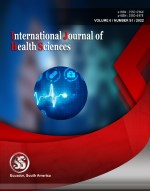Diabetic retinopathy detection using deep learning based neural network along with machine learning algorithms
Keywords:
diabetic retinopathy, neural network, machine learning algorithmsAbstract
Diabetic retinopathy (DA) is an eye disease caused by retinal damage as a result of long-term diabetes mellitus. Microaneurysms (MA)are an indicator of DA and are small red spots formed on the retina caused by the ballooning of a weak blood artery.The DA is mainly classified between Proliferate diabetic retinopathy (PDR) and Non-proliferative diabetic retinopathy (NPDR). Non-proliferative is an earlier stage of DA. In our study we will classify the images into 5 stages based on their severity of DA taken from a dataset. The existing modelshave usedLogistic Regression (LR), Support Vector Machine (SVM), gradient boosting techniques such as XGBoost and Logistic Regression with Elastic-Net penalty (LR-EN), to classify wavelet features among the groups. In our project study we used theDeeplearning-based algorithmFast R-CNN (Region Convolutional Neural Network) to build the model and tested its accuracy in training as well as testing the same model with other Machine learning techniques like Decision Tree, k-nearest neighbors (k-NN) classifier, GaussianNaïve Bayes, Kernel-SVM. Our project study shows that Decision Tree had the best training accuracy with 99.31% whereas in case ofthe best predicted testing accuracy it is k-Nearest Neighbors (k-NN) Classifier with 71.29%.
Downloads
References
Z. Liu, C. Wang, X. Cai, H. Jiang and J. Wang, "Discrimination of Diabetic Retinopathy From Optical Coherence Tomography Angiography Images Using Machine Learning Methods," in IEEE Access, vol. 9, pp. 51689-51694, 2021, doi : 10.1109/ACCESS.2021.3056430.
L. Qiao, Y. Zhu and H. Zhou, "Diabetic Retinopathy Detection Using Prognosis of Microaneurysm and Early Diagnosis System for Non-Proliferative Diabetic Retinopathy Based on Deep Learning Algorithms," in IEEE Access, vol. 8, pp. 104292-104302, 2020, doi: 10.1109/ACCESS.2020.2993937.
X. Li, X. Hu, L. Yu, L. Zhu, C. -W. Fu and P. -A. Heng, "CANet: Cross-Disease Attention Network for Joint Diabetic Retinopathy and Diabetic Macular Edema Grading," in IEEE Transactions on Medical Imaging, vol. 39, no. 5, pp. 1483-1493, May 2020, doi: 10.1109/TMI.2019.2951844.
C. -H. Hua et al., "Convolutional Network With Twofold Feature Augmentation for Diabetic Retinopathy Recognition From Multi-Modal Images," in IEEE Journal of Biomedical and Health Informatics, vol. 25, no. 7, pp. 2686-2697, July 2021, doi: 10.1109/JBHI.2020.3041848.
M. M. Abdelsalam and M. A. Zahran, "A Novel Approach of Diabetic Retinopathy Early Detection Based on Multifractal Geometry Analysis for OCTA Macular Images Using Support Vector Machine," in IEEE Access, vol. 9, pp. 22844-22858, 2021, doi: 10.1109/ACCESS.2021.3054743.
I. P. Okuwobi, Z. Ji, W. Fan, S. Yuan, L. Bekalo and Q. Chen, "Automated Quantification of Hyperreflective Foci in SD-OCT With Diabetic Retinopathy," in IEEE Journal of Biomedical and Health Informatics, vol. 24, no. 4, pp. 1125-1136, April 2020, doi: 10.1109/JBHI.2019.2929842.
F. Nunes et al., "A Mobile Tele-Ophthalmology System for Planned and Opportunistic Screening of Diabetic Retinopathy in Primary Care," in IEEE Access, vol. 9, pp. 83740-83750, 2021, doi: 10.1109/ACCESS.2021.3085404.
Y. Peng et al., "Automatic Staging for Retinopathy of Prematurity With Deep Feature Fusion and Ordinal Classification Strategy," in IEEETransactions on Medical Imaging, vol. 40, no. 7, pp. 1750-1762, July 2021, doi: 10.1109/TMI.2021.3065753.
A. Umamageswari, J. Shiny Duela and K. Raja, "Identifying Diabetics Retinopathy using Deep Learning based Classification," 2021 22nd International Arab Conference on Information Technology (ACIT), 2021, pp. 1-6, doi: 10.1109/ACIT53391.2021.9677209.
Hwang DK, Hsu CC, Chang KJ, Chao D, Sun CH, Jheng YC, Yarmishyn AA, Wu JC, Tsai CY, Wang ML, Peng CH, Chien KH, Kao CL, Lin TC, Woung LC, Chen SJ, Chiou SH. Artificial intelligence-based decision-making for age-related macular degeneration. Theranostics 2019; 9(1):232-245. doi:10.7150/thno.28447.
Garikapati, P. R., Balamurugan, K., Latchoumi, T. P., & Shankar, G. (2022). A Quantitative Study of Small Dataset Machining by Agglomerative Hierarchical Cluster and K-Medoid. In Emergent Converging Technologies and Biomedical Systems (pp. 717-727). Springer, Singapore.
Imani E, Pourreza HR, Banaee T. Fully automated diabetic retinopathy screening using morphological component analysis. Comput Med Imaging Graph. 2015 Jul;43:78-88. doi: 10.1016/j.compmedimag.2015.03.004. Epub 2015 Mar 21. PMID: 25863517.
Islam, Sheikh Muhammad Saiful, MdMahedi Hasan, and Sohaib Abdullah. "Deep learning based early detection and grading of diabetic retinopathy using retinal fundus images." arXiv preprint arXiv:1812.10595 (2018).
Ranjeeth, S., Latchoumi, T. P., & Paul, P. V. (2021). Optimal stochastic gradient descent with multilayer perceptron based student's academic performance prediction model. Recent Advances in Computer Science and Communications (Formerly: Recent Patents on Computer Science), 14(6), 1728-1741.
Latchoumi, T. P., & Parthiban, L. (2022). Quasi oppositional dragonfly algorithm for load balancing in cloud computing environment. Wireless Personal Communications, 122(3), 2639-2656.
Krause J, Gulshan V, Rahimy E, Karth P, Widner K, Corrado GS, Peng L, Webster DR. Grader Variability and the Importance of Reference Standards for Evaluating Machine Learning Models for Diabetic Retinopathy. Ophthalmology. 2018 Aug;125(8):1264-1272. doi: 10.1016/j.ophtha.2018.01.034. Epub 2018 Mar 13. PMID: 29548646.
Published
How to Cite
Issue
Section
Copyright (c) 2022 International journal of health sciences

This work is licensed under a Creative Commons Attribution-NonCommercial-NoDerivatives 4.0 International License.
Articles published in the International Journal of Health Sciences (IJHS) are available under Creative Commons Attribution Non-Commercial No Derivatives Licence (CC BY-NC-ND 4.0). Authors retain copyright in their work and grant IJHS right of first publication under CC BY-NC-ND 4.0. Users have the right to read, download, copy, distribute, print, search, or link to the full texts of articles in this journal, and to use them for any other lawful purpose.
Articles published in IJHS can be copied, communicated and shared in their published form for non-commercial purposes provided full attribution is given to the author and the journal. Authors are able to enter into separate, additional contractual arrangements for the non-exclusive distribution of the journal's published version of the work (e.g., post it to an institutional repository or publish it in a book), with an acknowledgment of its initial publication in this journal.
This copyright notice applies to articles published in IJHS volumes 4 onwards. Please read about the copyright notices for previous volumes under Journal History.
















